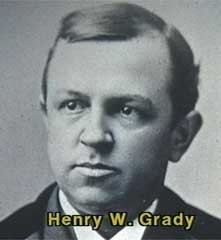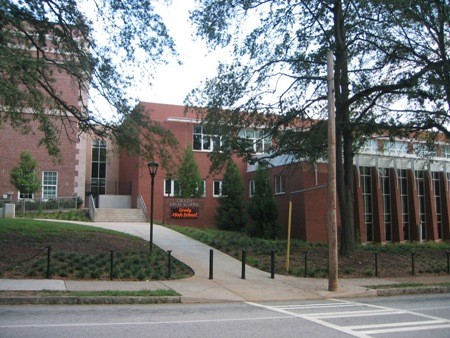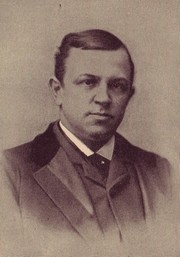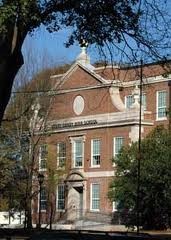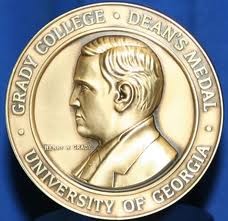Grady High School
Classes of 1959 - 1990
Henry W. Grady
Click on Photos of Henry Grady
A Brief History of Henry W. Grady High School
When school opened on our site for the school year 1924-1925 Atlanta's schools were segregated both by gender and by race. Our school began, therefore, as an institution for white males, divided into Boy's High and Tech High. Because Boy's High and Tech High were the only high schools for white males in early twentieth century Atlanta, the schools count among their graduates many of Atlanta's most influential citizens in the last fifty years.
In 1947 the complexion of the school changed. We became a co-educational, neighborhood school that was renamed Henry W. Grady High School. Henry Grady, for whom the school was named, was the editor of the Atlanta Constitution for nearly tweny years after the Civil War. A well known orator and writer, Grady proclaimed the advent of what he called the New South.
At the time that Grady High School received its new name, it also went through a physical transformation. The office, media center, and a few classrooms were added to the main wing. The original neo-classical design of Grady High School in 1924 and the renovation in 1950 was the work of an architect named Philip Shutze who is now recognized as one of Atlanta's finest architects, famous for such monuments as the Swan House and Glenn Memorial Church.
As this new Henry Grady High School emerged, a faculty that was drawn from both Boy's and Girl's High inspired a burst of creativity. The school yearbook was renamed The Orator and the newspaper The Southerner, names that clearly alluded to Henry Grady's career. And within a short time, The Southerner was named the best school newspaper in the state and The Orator the third best yearbook. This creative period in the 1950's is still reflected in the cafeteria mural depicting the merger of Girls High and Boys High in an idyllic panorama of boys and girls mingling in Piedmont Park with new school in the background.
The cafeteria painting is a reminder of the excitement that was felt in the 1950's when Atlanta Public Schools were first made co-educational. (You can view the cafeteria mural in our website photo gallery). But, obviously, this new coed, neighborhood school did not include every high school age child in the neighborhood. Not until 1961 did Grady High School begin racial integration of the student body. At that time the school became one of the first high schools in the state of Georgia to open its doors to African-American students. Racial integration at Grady made the news both in the state and in the nation as integration proceeded throughout the 1960's and 1970's. But the makeup of Grady's school population stabilized between 1980 and 1985 . For the past ten years Grady's ethnic composition has remained close to 70% Black, 29% white, and 1% other.
The stabilization of the ethnic makeup of Grady coincided with dramatic changes in the administrative leadership of the school. In 1981 Thomas Adger became principal, and Kay Earnhardt became the coordinator of the new Communication Magnet Program. These two leaders fostered a renaissance at Grady that continues to provide inspiration to the school. They emphasized hiring creative faculty members, providing flexible scheduling for electives, encouraging cooperation between academic departments, creating advanced placement classes, procuring better technology and equipment from the business community, and developing the community's trust of the school. They made Grady a showcase for student talent through revitalized publications, a debate team, and a schoolwide festival for the humanities. They were particularly successful in inspiring teachers and students to experiment. They provided encouragement and support, but they let the school community create without interference. Finally, in 1987-88 they led us through another major renovation of the building. Renovations included:
In 1947 the complexion of the school changed. We became a co-educational, neighborhood school that was renamed Henry W. Grady High School. Henry Grady, for whom the school was named, was the editor of the Atlanta Constitution for nearly tweny years after the Civil War. A well known orator and writer, Grady proclaimed the advent of what he called the New South.
At the time that Grady High School received its new name, it also went through a physical transformation. The office, media center, and a few classrooms were added to the main wing. The original neo-classical design of Grady High School in 1924 and the renovation in 1950 was the work of an architect named Philip Shutze who is now recognized as one of Atlanta's finest architects, famous for such monuments as the Swan House and Glenn Memorial Church.
As this new Henry Grady High School emerged, a faculty that was drawn from both Boy's and Girl's High inspired a burst of creativity. The school yearbook was renamed The Orator and the newspaper The Southerner, names that clearly alluded to Henry Grady's career. And within a short time, The Southerner was named the best school newspaper in the state and The Orator the third best yearbook. This creative period in the 1950's is still reflected in the cafeteria mural depicting the merger of Girls High and Boys High in an idyllic panorama of boys and girls mingling in Piedmont Park with new school in the background.
The cafeteria painting is a reminder of the excitement that was felt in the 1950's when Atlanta Public Schools were first made co-educational. (You can view the cafeteria mural in our website photo gallery). But, obviously, this new coed, neighborhood school did not include every high school age child in the neighborhood. Not until 1961 did Grady High School begin racial integration of the student body. At that time the school became one of the first high schools in the state of Georgia to open its doors to African-American students. Racial integration at Grady made the news both in the state and in the nation as integration proceeded throughout the 1960's and 1970's. But the makeup of Grady's school population stabilized between 1980 and 1985 . For the past ten years Grady's ethnic composition has remained close to 70% Black, 29% white, and 1% other.
The stabilization of the ethnic makeup of Grady coincided with dramatic changes in the administrative leadership of the school. In 1981 Thomas Adger became principal, and Kay Earnhardt became the coordinator of the new Communication Magnet Program. These two leaders fostered a renaissance at Grady that continues to provide inspiration to the school. They emphasized hiring creative faculty members, providing flexible scheduling for electives, encouraging cooperation between academic departments, creating advanced placement classes, procuring better technology and equipment from the business community, and developing the community's trust of the school. They made Grady a showcase for student talent through revitalized publications, a debate team, and a schoolwide festival for the humanities. They were particularly successful in inspiring teachers and students to experiment. They provided encouragement and support, but they let the school community create without interference. Finally, in 1987-88 they led us through another major renovation of the building. Renovations included:
- adding a theatre
- air conditioning of the main building
- installing carpets in most classrooms
- replacing windows in the Eighth Street wing
- cleaning the facade
- installing a closed circuit television system
- creating an improved art room
- adding a communications wing with a large darkroom and desktop publishing area.
The theme of the school in the 1980's was "All Children Can Learn." That philosophy was soon apparent because test scores in the 1980's improved throughout the student body, not just among those students in the magnet program. Georgia Basic Skills Test scores, for instance, jumped dramatically from 1987 to 1989. SAT scores from 1986 to 1990 show a similar pattern: an average verbal score of 350 in 1986 soared to 422 in 1990.
Much of what was accomplished in the 1980's was recognized in 1991 when Grady High School was named a School Of Excellence for the state of Georgia. The intangible that accounted for much of the turnaround was the school's genuine acceptance of diversity. We were a school where racism, sexism, and cultural bias that was still prevalent in the surrounding society were largely excluded. Students were learning well, partly because past stereotypes were not hindering them in their interactions with each other or with their teachers.
Grady High School in the 1990's has hardly missed a beat. Grady's staff has changed radically in the last three years largely because of retirements and promotions. Led by a new principal, Dr. Vincent Murray, the school has adjusted to the change. Additions in personnel have included many new teachers, counselors, a new magnet coordinator, a new registrar, and a new assistant principal. Creativity in the faculty has been encouraged by Dr. Murray 's shared leadership approach. The science department now has a stronger emphasis upon laboratory science as well as innovations in the teaching of ecology. Vocational education has developed a new program in graphic communications as well as installing a business education lab with 29 IBM word processors capable of desktop publishing.
These recent accomplishments were recognized again in 1994-95 when, once again, Grady High School was named a School of Excellence. In 1996 Redbook Magazine cited Grady High School as one of twenty schools nationwide using innovative teaching methods in the classroom.
Much of what was accomplished in the 1980's was recognized in 1991 when Grady High School was named a School Of Excellence for the state of Georgia. The intangible that accounted for much of the turnaround was the school's genuine acceptance of diversity. We were a school where racism, sexism, and cultural bias that was still prevalent in the surrounding society were largely excluded. Students were learning well, partly because past stereotypes were not hindering them in their interactions with each other or with their teachers.
Grady High School in the 1990's has hardly missed a beat. Grady's staff has changed radically in the last three years largely because of retirements and promotions. Led by a new principal, Dr. Vincent Murray, the school has adjusted to the change. Additions in personnel have included many new teachers, counselors, a new magnet coordinator, a new registrar, and a new assistant principal. Creativity in the faculty has been encouraged by Dr. Murray 's shared leadership approach. The science department now has a stronger emphasis upon laboratory science as well as innovations in the teaching of ecology. Vocational education has developed a new program in graphic communications as well as installing a business education lab with 29 IBM word processors capable of desktop publishing.
These recent accomplishments were recognized again in 1994-95 when, once again, Grady High School was named a School of Excellence. In 1996 Redbook Magazine cited Grady High School as one of twenty schools nationwide using innovative teaching methods in the classroom.
Since 1891, the statue of Henry W. Grady has stood at the intersection of Marietta Street and Forsyth Street in downtown Atlanta. Grady was born in Athens, Ga. in 1850 and died 49 years later (1889) in Atlanta. Grady was an influential editor of the Atlanta Constitution newspaper in the 1880s. An aggressive promoter of Atlanta's economic growth in the years following the Civil War, Grady coined the term the New South to describe his belief in the region's need for industrial development in the years following the Civil War. Both Grady Hospital and Grady High School are named in his honor.
This bronze statue of Atlanta Constitution editor Henry W. Grady, cost $20,000 and was paid for by donations from all over the country. His daughter, Miss Gussie Grady, unveiled the statue in 1892 before a crowd of 25,000.
Date: postmarked 1938
.jpg)
